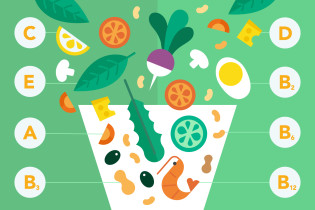Palm oil (Q&A)
Last Updated : 20 September 2013Frequently asked questions
1. What is palm oil?
Palm oil is an edible vegetable oil produced from the pulp of the fruits of palms and that is solid at room temperature. The fleshy pulp contains about 50% oil. Crude palm oil has a red colour owing to its high carotenoid content. In Europe, palm oil is usually sold and consumed in its refined form, i.e. after it has been bleached and deodorised. Most carotenoids are lost during refining. It should not be confused with palm kernel oil derived from the kernel of the same fruit, or coconut oil derived from the kernel of the coconut palm.
Crude palm oil contains 'minor' compounds: vitamin E, phytosterols and phenolic compounds. All vegetable oils contain vitamin E in varying amounts and different forms, but palm oil has the distinctive feature of largely containing tocotrienols and tocopherols with high vitamin E activity. The refining process causes some vitamin E loss.
2. Which products contain palm oil?
About 80 % of the palm oil produced is used in the food industry globally. It can be found in a wide range of food products such as cooking oils, margarine, fats for baking, pastries, biscuits, ice cream and various other kinds of foods.
3. Why is palm oil used?
Palm oil has specific functional properties that make it an important ingredient in food manufacturing. It contributes to taste, heat stability, resistance to oxidation, texture and smoothness. Importantly, palm oil virtually contains no trans fatty acids. In recent years the replacement of partially hydrogenated vegetable oils, a source of trans fatty acids, has led to an increased use of palm oil to lower trans fatty acids in foods. No other vegetable fats naturally solid at room temperature and providing the same features exist in sufficient quantity.
4. How much palm oil do we consume and what are the recommendations?
No Europe-wide data seem to exist on palm oil consumption. In France, current palm oil consumption is estimated at 5.5 g per person per day, or 2 kg per person per year (based on disappearance data, i.e. a hypothetical balance between import and export of finished products containing palm oil; actual intake is likely to be lower). This represents around 6 % of total fat consumption in French adults aged 18 to 79, which is considered to be low. The estimate equals a consumption of saturated fatty acids from palm oil of around 2.7 g per person, per day. In comparison, a person with a daily energy need of 2000 kilocalories is recommended to not exceed about 20 g of saturated fats per day.
Reports of recent surges in palm oil consumption are linked to the phasing out of partially hydrogenated vegetable oils, which are a source of undesirable trans fats (note that fully hydrogenated oils do not contain any trans fats).
5. Is the consumption of palm oil a health concern?
There are no health concerns specific to palm oil. The relation between nutrition and health must be considered over the whole diet and not in terms of single food items. Exceeding recommended intakes for saturated fat – from any source – is undesirable.
Palm oil contains 50% saturated fat, which compares favourably to the saturated fat content of other fats of similar application: coconut (92%), palm kernel (84%), butter (66%), cocoa butter (62%) and tallow (54%). Moreover, in food products palm oil is often used together with other fats and oils which together determine the fatty acid composition and eventually the effects on health. All oils and fats contain both saturated and unsaturated fatty acids.
At the same time, using palm oil in place of partially hydrogenated vegetable oils reduces the content of trans fats in foods made with these oils. Both saturated and trans fats can raise LDL (bad) cholesterol levels. However, unlike saturated fats, trans fats also lead to a fall in HDL (good) cholesterol and raise blood triglyceride levels, both of which are associated with an increased risk of coronary heart disease.
Overall, the European Food Safety Authority recommends that intakes of saturated fats and trans fats be as low as possible.
6. Is palm oil labelled on food products?
Many food products currently do not label palm oil. From December 2014, European legislation (Regulation (EU) No 1169/2011) obliges all individual oils present in food to be indicated on the label. No specific labelling of trans fatty acids will be required. However, by 31 December 2014 the European Commission shall submit a report on the presence of trans fatty acids in foods to decide whether further information on the label is required or their use should be restricted.
7. How does palm oil production compare to other oil crops?
Per acre of land, yields from the oil palm may be up to tenfold higher than for instance soya, rape and sunflower. Moreover, the oil palm cultivation occupies 7 % of the agricultural surface area dedicated to oil crops, which is smaller than the share dedicated to soya (61 %), rape (18 %) and sunflower (14 %). However, because of the exceptional oil yields it supplies 39 % of world vegetable oil production.
The oil palm is cultivated exclusively in humid tropical regions. Today, the majority of palm oil production is supplied by two countries: Indonesia and Malaysia. These two countries together account for 87% of world supplies.
8. How do I know that palm oil production is sustainable?
The Roundtable on Sustainable Palm Oil (RSPO) certification is a seal of approval that the palm oil was produced without undue harm to the environment or society and that the product is traceable through the supply chain. Growers have to comply with the principles and criteria of RSPO that cover rights of previous land owners, local communities, workers and small farmers as well as no new primary forests or high conservation value areas have been cleared for palm oil production since November 2005. The RSPO is an international multi-actor initiative for the certification and promotion of sustainable palm oil practices. The RSPO was founded in 2004 and certified sustainable palm is available on the market since 2008. Already 1.3 million hectares of plantations area have been certified. This accounts for approximately 10 % of the cultivated surface area.
Members of RSPO include environmental and conservation organisations such as the World Wide Fund for Nature (WWF), the Global Environment Centre, and Fauna and Flora International.
9. What are the socio-economic implications of palm oil production for local communities?
Oil palm cultivation can generate high, stable revenues. It can create a rural middle class lasting several generations. Few tropical primary materials have been able to do that to date. As such, in Sumatra, Indonesia, the average income in a complete financial year of an oil palm plantation is as much as 2100 EUR per hectare, as compared to only 200 EUR for a rice plantation. This equals the respective daily wages of 36 EUR vs. 1.7 EUR. It is estimated that there are 25 million Indonesians living indirectly from oil palm exploitation.
10. Should palm oil in food products be replaced by other fats?
From a nutritional perspective, the replacement of palm oil from food products is not recommended. Its high content in saturated fats justifies moderating its consumption but current consumption levels of palm oil, as suggested by data from France (see FFAS report) are not a source of particular concern. A healthy and balanced diet relies on diversity and moderation.
From the environmental and social perspective, it would be more important to focus on sustainable production of palm oil. Substituting palm oil with other vegetable oils or animal fats would require using more land for equivalent tonnage, which would be counter-productive for the environment. The consequences of banning this ingredient would have a negative impact on the world’s food supply.
References
- European Food Safety Authority. Scientific Opinion on Dietary Reference Values for fats, including saturated fatty acids, polyunsaturated fatty acids, monounsaturated fatty acids, trans fatty acids, and cholesterol. EFSA Journal 2010; 8(3):1461. doi:10.2903/j.efsa.2010.1461
- Fonds Français pour l’Alimentation et la Santé (FFAS), Scientific Status Report on Palm Oil (in English) - Annexes
- REGULATION (EU) No 1169/2011 of 25 October 2011 on the provision of food information to consumers, amending Regulations (EC) No 1924/2006 and (EC) No 1925/2006 of the European Parliament and of the Council, and repealing Commission Directive 87/250/EEC, Council Directive 90/496/EEC, Commission Directive 1999/10/EC, Directive 2000/13/EC of the European Parliament and of the Council, Commission Directives 2002/67/EC and 2008/5/EC and Commission Regulation (EC) No 608/2004.
- RSPO Palm Oil Factsheet



